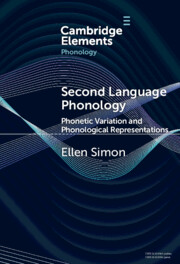Refine search
Actions for selected content:
39 results
Regional differences in Central Yiddish vowel length: Central Poland and the Unterland
-
- Journal:
- Language Variation and Change / Volume 37 / Issue 2 / July 2025
- Published online by Cambridge University Press:
- 15 October 2025, pp. 213-239
-
- Article
-
- You have access
- Open access
- HTML
- Export citation
Phonetic variables in African Frenches: Social variation in Kinshasa French vowel systems
-
- Journal:
- Journal of French Language Studies / Volume 35 / 2025
- Published online by Cambridge University Press:
- 01 August 2025, e12
-
- Article
-
- You have access
- Open access
- HTML
- Export citation
Acoustic analysis of like in North-West England shows context effects, but not function effects
-
- Journal:
- English Language & Linguistics , First View
- Published online by Cambridge University Press:
- 31 July 2025, pp. 1-20
-
- Article
-
- You have access
- Open access
- HTML
- Export citation
Phonological and Lexical Conditioning of TRAP Vowel Duration in Australian English
-
- Journal:
- Journal of the International Phonetic Association / Volume 55 / Issue 1-2 / August 2025
- Published online by Cambridge University Press:
- 15 July 2025, pp. 65-91
-
- Article
-
- You have access
- Open access
- HTML
- Export citation

Second Language Phonology
- Phonetic Variation and Phonological Representations
-
- Published online:
- 20 March 2025
- Print publication:
- 27 March 2025
-
- Element
- Export citation
[bɪt] by [bɪʔ]: Variation in T-glottaling in Scottish Standard English
-
- Journal:
- Language Variation and Change / Volume 36 / Issue 1 / March 2024
- Published online by Cambridge University Press:
- 07 March 2024, pp. 49-72
-
- Article
- Export citation
14 - Have Cantonese Tones Merged in Spontaneous Speech?
-
-
- Book:
- The Phonetics and Phonology of Heritage Languages
- Published online:
- 15 February 2024
- Print publication:
- 22 February 2024, pp 302-320
-
- Chapter
- Export citation
15 - Phonetics of Stop Voicing in Heritage and Homeland Polish
-
-
- Book:
- The Phonetics and Phonology of Heritage Languages
- Published online:
- 15 February 2024
- Print publication:
- 22 February 2024, pp 321-342
-
- Chapter
- Export citation
Boomer Peak or Gen X Cliff? From SVS to LBMS in Georgia English
-
- Journal:
- Language Variation and Change / Volume 35 / Issue 2 / July 2023
- Published online by Cambridge University Press:
- 24 July 2023, pp. 175-197
-
- Article
-
- You have access
- Open access
- HTML
- Export citation
The role of speaker sex and sexuality in an ongoing sound change: Nasal vowels in Parisian French
-
- Journal:
- Journal of French Language Studies / Volume 33 / Issue 3 / November 2023
- Published online by Cambridge University Press:
- 11 July 2023, pp. 357-384
-
- Article
-
- You have access
- Open access
- HTML
- Export citation
Social factors in accent recognition: a large-scale study in perceptual dialectology
-
- Journal:
- Journal of Linguistic Geography / Volume 11 / Issue 2 / October 2023
- Published online by Cambridge University Press:
- 11 July 2023, pp. 78-90
-
- Article
-
- You have access
- Open access
- HTML
- Export citation
Medium-shifting and intraspeaker variation in conversational interviews
-
- Journal:
- Language Variation and Change / Volume 34 / Issue 3 / October 2022
- Published online by Cambridge University Press:
- 25 January 2023, pp. 305-329
-
- Article
-
- You have access
- Open access
- HTML
- Export citation
A sociophonetic account of gradient /z/ devoicing among Chicanx high schoolers
-
- Journal:
- Language Variation and Change / Volume 34 / Issue 2 / July 2022
- Published online by Cambridge University Press:
- 19 October 2022, pp. 165-182
-
- Article
- Export citation
Social meaning in archival interaction: a mixed-methods analysis of variation in rhoticity and past tense be in Oldham
-
- Journal:
- English Language & Linguistics / Volume 26 / Issue 4 / December 2022
- Published online by Cambridge University Press:
- 25 July 2022, pp. 861-887
-
- Article
-
- You have access
- Open access
- HTML
- Export citation
The influence of language shift on Sanapaná vowels: An exemplar-based perspective
-
- Journal:
- Language Variation and Change / Volume 34 / Issue 1 / March 2022
- Published online by Cambridge University Press:
- 16 May 2022, pp. 107-135
-
- Article
- Export citation
Spatial analysis of sub-regional variation in Southern US English
-
- Journal:
- Journal of Linguistic Geography / Volume 9 / Issue 2 / October 2021
- Published online by Cambridge University Press:
- 08 February 2022, pp. 86-105
-
- Article
-
- You have access
- Open access
- HTML
- Export citation

Accent in North American Film and Television
- A Sociophonetic Analysis
-
- Published online:
- 16 December 2021
- Print publication:
- 16 December 2021
22 - Sociophonetics
- from Section V - Applications of Phonetics
-
-
- Book:
- The Cambridge Handbook of Phonetics
- Published online:
- 11 November 2021
- Print publication:
- 02 December 2021, pp 551-577
-
- Chapter
- Export citation
Forced alignment for Nordic languages: Rapidly constructing a high-quality prototype
-
- Journal:
- Nordic Journal of Linguistics / Volume 46 / Issue 1 / May 2023
- Published online by Cambridge University Press:
- 01 December 2021, pp. 105-131
-
- Article
-
- You have access
- Open access
- HTML
- Export citation
6 - The Cognitive Structure behind Indexicality: Correlations in Tasks Linking /s/ Variation and Masculinity
- from Part I - Where Is (Social) Meaning?
-
-
- Book:
- Social Meaning and Linguistic Variation
- Published online:
- 30 July 2021
- Print publication:
- 12 August 2021, pp 127-150
-
- Chapter
- Export citation
